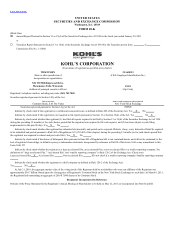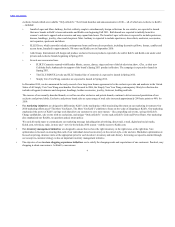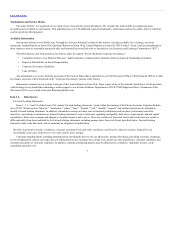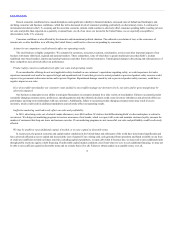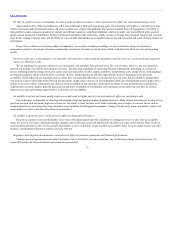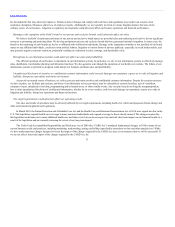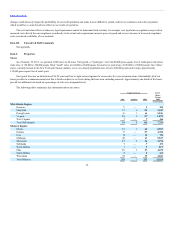Kohl's 2010 Annual Report Download - page 9
Download and view the complete annual report
Please find page 9 of the 2010 Kohl's annual report below. You can navigate through the pages in the report by either clicking on the pages listed below, or by using the keyword search tool below to find specific information within the annual report.
Table of Contents
when required by our business circumstances could have a material adverse effect on us including an inability to fund new growth and other capital
expenditures.
In 2010, we entered into a derivative product to manage our exposure to interest rates on debt that we expect to issue in late 2011. Disruptions or turmoil
in the financial markets could lead to losses on this derivative position resulting from counterparty failures.
Our goal is to invest capital to maximize our overall long-term returns. This includes spending on inventory, capital projects and expenses, managing
debt levels, and periodically returning value to our shareholders through share repurchases and dividends. To a large degree, capital efficiency reflects how
well we manage our other key risks. The actions taken to address other specific risks may affect how well we manage the more general risk of capital
efficiency. If we do not properly allocate our capital to maximize returns, we may fail to produce optimal financial results and we may experience a reduction in
shareholder value.
Our credit card operations facilitate sales in our stores and generate additional revenue from fees related to extending credit. The proprietary Kohl’s credit
card accounts have been sold to an unrelated third-party, but we share in the net revenues of the program according to a fixed percentage. Net revenues are
settled monthly and include finance charge and late fee revenues, less write-offs of uncollectible accounts and other expenses.
In August 2010, we entered into a Private Label Credit Card Program Agreement with Capital One, National Association (“Capital One”), which will be
effective upon transition of the outstanding receivables from our former partner to Capital One. We currently expect this transition to occur in the first fiscal
quarter of 2011. Kohl’s and Capital One will share in the net risk-adjusted revenue of the portfolio, which is defined as the sum of finance charges, late fees
and other revenue less write-offs of uncollectible accounts. Changes in funding costs related to interest rate fluctuations will be shared similar to the revenue.
Though management currently believes that increases in funding costs will be largely offset by increases in finance charge revenue, increases in funding costs
could adversely impact the profitability of this program.
Changes in credit card use, payment patterns and default rates may also result from a variety of economic, legal, social and other factors that we cannot
control or predict with certainty. Changes that adversely impact our ability to extend credit and collect payments could negatively affect our results.
Because a significant portion of our business is apparel and subject to weather conditions in our markets, our operating results may be adversely
affected by severe or unexpected weather conditions. Frequent or unusually heavy snow, ice or rain storms or extended periods of unseasonable temperatures in
our markets could adversely affect our performance by affecting consumer shopping patterns or diminishing demand for seasonal merchandise.
Our business is subject to seasonal influences, with a major portion of sales and income historically realized during the second half of the fiscal year,
which includes the back-to-school and holiday seasons. This seasonality causes our operating results to vary considerably from quarter to quarter and could
materially adversely affect the market price of our common stock.
9

